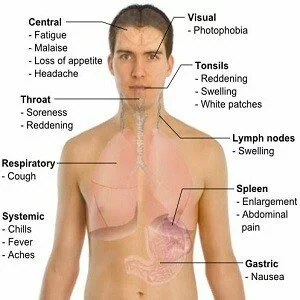A fever exists when the body temperature is raised; this in itself is not a disease but an indication that something may be wrong somewhere in the body. The human body through several processes and activities generates a lot of heat and also removes it to maintain a balance.
When our body heat reaches a certain level, more blood flows to the skin and we sweat to remove heat from our body until the normal level is attained. When we are cold, less blood flows to the skin in order to conserve heat, if the normal body temperature is not attained we shiver to generate more heat. It is the failure of this mechanism due to several reasons that leads to fever.
The body temperature is measured using a thermometer; it could be measured in the mouth, rectum, armpit or ear and also on the skin of the forehead. Normal body temperature varies from person to person and during the day. It is lowest in the morning and highest in the early evening and night. Physical activities increase body temperature, also hot beverages.
The normal body temperature ranges from 36.5 to 37.2 degrees Celsius (97.7-99.5deg. F)
Mild fever exists if the body temperature is 38 deg. Celsius (100.4 deg. F); fever is high if the body temperature is 40 deg. Celsius and above (104 deg. F and above).
Owing to the Ebola Virus Disease, everyone with some health literacy is now very conscious of body temperature; temperatures are taken before entering some banks and offices; ditto at airports (both arrival and departure). Those with fever could be denied and asked to see a doctor.
Physical activities increase body temperature, also hot beverages; recorders of temperatures at the above points must have this in mind.
Fever can result from several conditions, some of which are listed below:
1. Infections Bacterial, viral and some fungal and parasitic infections cause fever; such infections include malaria, typhoid, cholera, Ebola Virus Disease, Hepatitis, Poliomyelitis and pneumonias. Most communicable diseases present with fever, this leads to some difficulties in arriving at accurate diagnosis.
2. Medicines Some medicines interfere with the heat dissipating mechanism of our body, such drugs include anti-histamines among others. Some antibiotics also cause fever, also some illicit drugs like cocaine and amphetamines.
3. Injuries- Physical and non-physical. Injuries resulting from road traffic accidents, falls and burns can cause fever. Non-physical accidents such as heart attack and stroke also cause fever.
4. Exposure to Heat: Heat exhaustion, Heatstroke. Both conditions are associated with fever. Heat Exhaustion follows prolonged physical activity in a hot environment with inadequate water or salt intake. Body temperature could rise up to 37.8 deg. C.
Heat stroke is far more severe than heat exhaustion. It could result from prolonged physical exertion in a hot or humid environment without water or salt intake. The body temperature could go as high as 40 deg. C. and there
is loss of consciousness.
Heat stroke has a high mortality rate.
5. Auto-immune conditions Some auto-immune diseases are accompanied by fever; in auto-immune diseases, the body fights against itself, destroys itself by producing antibodies against itself. Such diseases include Systemic lupus
Erythematosus and Rheumatoid arthritis.
6. Hormonal Diseases and Hormonal Changes. Some diseases due to increased hormone (body chemical) production can cause fever, the most prominent being that produced by the Thyroid Gland in a condition called Thyrotoxicosis.
The Thyroid Gland is an organ in front of the neck which could become big in a condition called GOITRE. Also, hormonal changes in women during the monthly cycles do cause some raise in body temperature.
7.Cancers Cancers are associated with low grade persistent fever, these include Liver cancer, Lung cancer, Hodgkin’s Lymphoma and Prostate cancer among others.
In many cases, it is the persistent fever that drags the affected person to the doctor for examination and diagnosis.



No Comments